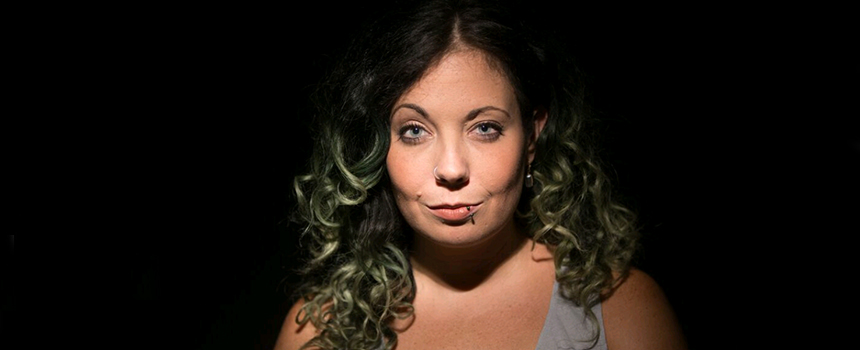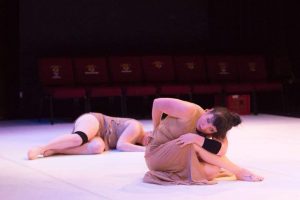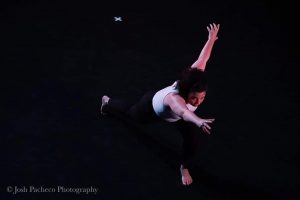Accessibility
Instructor Spotlight: Jamie Murphy


Jamie Murphy does it all. Some days, she’s instructing contemporary and jazz classes to Pittsburgh Ballet Theatre School Student, Pre-professional and Community Division students, and working for PBT’s education department teaching accessibility classes within the Pittsburgh community. Others, she’s a performer, finding time to shine in the spotlight herself with dance companies around the region. Her enthusiasm and passion for dance make an impact on everyone she comes across. Get to know Jamie – who has been a part of the Pittsburgh Ballet Theatre School family for 12 years – and check out her contemporary classes for ages 14+ on mindbody.com.
FUN FACTS
Hometown: Youngstown, Ohio
Family: “My awesome parents, Kathy and James, live in Ohio and my older sister and fellow modern dancer lives in Philadelphia.”
Hobbies: “I love crafting, baking, going to arts events and catching up with friends over a glass of wine!”
Favorite food: “Potatoes of any kind!”
Favorite musician/song: “I’ve been a hardcore Elvis fan since the age of 3.”
Favorite form of exercise: “Yoga and dance classes.”
Favorite music genre to dance to: “Anything with a good beat really! I love having an eclectic playlist in class.”
Q&A
How long have you been instructing dance classes?
“I have been teaching for 14 years. This is my twelfth year with PBT teaching jazz, modern and contemporary in the school, as well as educational outreach and accessibility classes for our education department the past eight years.”
How do you find time to balance a professional career and teaching?
“This can be tricky sometimes. Because I teach a lot, sometimes it is hard for me to take classes for myself. However, I am very lucky to have incredibly supportive directors (Margie Grundvig and Kati Gigler) who allow me the space and time to keep rehearsing, performing and creating outside of PBT.”
Describe your career “epiphany” – the moment you knew this was what you wanted to do professionally.
“I can’t remember a time where dance wasn’t one of the most important parts of my life. It’s hard to pinpoint an exact moment, because it always just felt like dance was in my future. I will say that I didn’t always intend to become a teacher. After I graduated from Point Park University, I was dancing with a few Pittsburgh-based companies and decided to try teaching to supplement my income. I really unexpectedly grew to love teaching and watching young dancers grow. It was my second year at PBT that really sealed the deal of me wanting to be an educator. It was the first time that I was part of a young dancers “a-ha moment” and I think I was more excited than them about their success.”

What’s the most fulfilling thing about being a dance instructor?
“I really think that my favorite part of being a teacher is watching the students experience new parts of themselves. For example, with the younger students, you see pure joy when watching them stick a pirouette for the first time. Getting to be there to witness their successes is a feeling like nothing else. With the older students, it’s watching the moment they turn from students into artists. Some of the students at PBT, I have had the chance to work with from Level 2 through the grad program. You watch them develop their skills over the years and then there is this beautiful moment where you can see all of that hard work turn into artistry. Getting to be a part of that is pretty awesome.”
What advice would you give someone who wants to try contemporary dance as an adult?
“DO IT!! If you have an interest in something, give it a shot! Contemporary dance really allows you to be expressive and connect to your emotions. You might discover parts of yourself you never knew existed while in the dance studio!”
What are the advantages of taking dance as an adult?
“While, of course, dance provides benefits to one’s health and fitness, I think the biggest advantages are having fun and expressing yourself. My community classes at PBT are always one of the highlights of my week, mostly due to the fact that the people that come are there to have fun and experience something for themselves. We get so busy with our everyday lives and all of the heaviness that the world throws at us. I believe that dance can give us a moment of escape and freedom to experience joy.”
What makes PBT a great place to dance?
“A combination of things makes PBT a great place to dance. We are so lucky to have a great facility that is big enough to offer so many experiences for so many people. Since I started 12 years ago, the Community Division has grown so much with so many different types of classes to choose from. I also love that PBT is making a huge effort to be inclusive by offering so many accessible classes for differently-abled bodies and people with neurodiversities. On top of all of that, I think it is really awesome that PBT is able to offer so many classes with live accompaniment. Whether it is percussion or piano, the students are so lucky to have the opportunity to learn in an environment with live musicians. I’m so proud to be on staff at Pittsburgh Ballet Theatre.”
Pittsburgh Ballet Theatre Pilots Audio Description Program at Dec. 14, Performance of The Nutcracker
Following the introduction of braille and large-print programs this season, Pittsburgh Ballet Theatre is piloting a new Audio Description Program at the 7 p.m. Dec. 14, performance of The Nutcracker to help patrons with vision impairments visualize the choreography, set design and costumes set to Tchaikovsky’s iconic score.
Beyond listening to live verbal descriptions during the production, patrons can get a full sensory experience by attending a pre-performance “Touch Tour” at 5:45 p.m. on Dec. 14, in the Benedum Center’s South Lounge. Assisted by a costumed dancer, attendees will have the opportunity to touch costume samples, such as the Sugarplum Fairy tutu’s stiff netting and intricate embellishment, a textured tactile map of the stage set layout and the poses of signature choreography, such as the carriage of the hands in the Snow Scene. Following the performance, PBT Education Director Alyssa Herzog Melby, who will audio describe the production, will host a feedback session with attendees to evaluate PBT’s first audio-described production.
“Although Pittsburgh already offers well-established audio description programs for opera and theatre, we believe this will be the first program in the Pittsburgh arts community that is specifically tailored to dance,” Melby said. “The thing about describing for dance which makes it so challenging–and rewarding–is that the describer can’t rely on dialogue or lyrics to help tell the story. The describer becomes a storyteller, painting a vivid mental picture for patrons of all the movement intricacies that are happening onstage.”
In preparation for the pilot program, Pittsburgh Ballet Theatre and the Pittsburgh Cultural Trust co-hosted an Audio Description for Dance training workshop at the PBT Studios led by expert dance describer Ermyn King of the Washington, D.C. area.
The training – which included representatives from the Cultural Trust, Pittsburgh Opera and City Theatre — was designed for describers with previous audio description training and experience. Using live dance demonstrations, the course covered best practices and dance description fundamentals, including Laban Movement Analysis, which uses concepts such as body, energy, space and time to characterize choreography. Many of the describers in attendance volunteer for other Pittsburgh arts organizations and now have the skills necessary to describe for Pittsburgh Ballet Theatre productions and other dance events in the city.
The audio description will stream live through the Benedum Center’s assistive listening devices, which ushers are trained to offer and explain to patrons. The headsets for the audio-described performance are available on a first-come, first-served basis at a kiosk in the Benedum Center lower lobby in the right hallway. Upon arrival, patrons should see an usher for more assistance. Patrons will be asked for an ID in order to borrow a headset.
For tickets or more information about The Nutcracker, click here.
